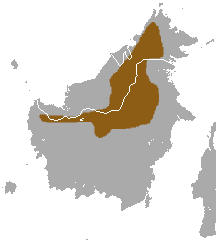Highland shrews
| Highland shrews | ||||||||||||
|---|---|---|---|---|---|---|---|---|---|---|---|---|
| Systematics | ||||||||||||
|
||||||||||||
| Scientific name | ||||||||||||
| Tupaia montana | ||||||||||||
| Thomas , 1892 |
The highland pointed squirrel ( Tupaia montana ), also called mountain tupaia, is a species of mammal from the family of the pointed squirrel (Tupaiidae).
Occurrence
The highland shrews only occur in Borneo and are one of ten species that have been detected there so far. Reasons for this could be size and habitat diversity, or that the shrews have their phylogenetic origin on Borneo and spread from there. They live in mountain forest areas and occasionally as crop followers on plantations.
morphology
Borneo highland shrews have a long and bushy tail or a long, pointed snout. The tail is densely hairy and serves as a climbing aid for the pointed squirrel. They reach a head-torso length of 11 to 15 centimeters head-torso length and have a tail length of 10 to 15 centimeters.
The coat color varies from brown to dark brown and is considerably lighter on the belly than the rest of the coat. The fur is dense and soft. The outer hairs are long and straight, the woolly hair short and soft. Except for the genus Dendrogale and the feather tail, mountain point squirrels have a light shoulder stripe.
Their ears are small and have a primate-like cartilaginous auricle with a membranous earlobe. They are slightly hairy.
Way of life
activity
Highland shrews are primarily ground dwellers and like to climb. They are omnivores and have exceptionally low brood care for higher mammals .
Unlike many other smaller mammals, mountain point squirrels are diurnal and although they are skilled climbers, they spend a lot of time on the ground foraging. The activity highlights are early morning and late afternoon. It feeds on small arthropods , but also on other invertebrates and plant parts, especially fruits and seeds, or scrapes resins and sap from trees and their leaves with their tooth comb.
In captivity, large shrews were seen catching mice and young rats and killing them with a neck bite. Pointed squirrels almost always go for food on the ground and look for their food by digging through the leaf litter with their snouts and paws. The prey is grabbed with the snout; only when the prey cannot be reached with the snout do shrews use their paws. Flying insects are caught with one or both paws in one quick movement. It is characteristic of shrews that they sit on their hind paws when they eat, while they hold the food with their front paws.
Probably this species has a stronger community life in small groups than other Tupaias. Communication by means of sounds is rather weak; Eight sounds are distinguished in the functional areas of contact, attention, alarm and aggression. The sounds are supported by the tail as an organ of expression; for example, he hits up and down when excited. Pointed squirrels squeak and screech during fights. Excited representatives of the genus Tupaia chatter loudly, this is often interpreted as a collective call that is uttered when potential enemies have been sighted.
While the other communication patterns are only moderately pronounced, communication via smells is very pronounced. They use extensive scent brands that consist of the secretions of certain glands and, more rarely, urine and feces . The scented secretions come from the glandular fields of the abdomen.
Tree and earth caves are primarily used as sleeping places, but also crevices in the rock, hollow bamboo trunks and hollows under large roots and fallen trees. When you sleep, shrews lie curled up; when you take short breaks, they simply lie on branches. The high activity body temperature of 40 ° C is reduced to 36 ° C during nighttime sleep phases. In general, shrews are quite insensitive to temperature fluctuations.
Reproduction and development
Highland shrews can reproduce year-round and are not tied to a specific time of year. After a gestation period of 49 to 51 days, the young animals are born in a nest built by the mother animal, which is separated from the resting and sleeping places of the parent animals. The nest is padded with leaves and other plant material by the mother a few days to a few hours before birth. The litter size is usually 2 animals.
Mountain pointed squirrels and humans
The reciprocal influences of mountain pointed squirrels and humans are small, but they have become rare due to the loss of habitat in mountain forests.
literature
- Louise H. Emmons: Tupai: A field study on bornean tree shrews . University of California Press, published 2000. ISBN 0-520-22291-1 .
- Robert D. Martin: Spitzhörnchen . In: David MacDonald (ed.): The great encyclopedia of mammals . Könemann in Tandem Verlag GmbH, Königswinter 2004 (translation of the English original edition from 2001); Pp. 426-431. ISBN 3-8331-1006-6 .
- Ronald M. Nowak: Walker's Mammals of the World . 6th edition. Johns Hopkins University Press, Baltimore 1999, ISBN 0-8018-5789-9 (English).
- K. Kolar among others: shrews and monkeys . In: Bernhard Grzimek (Ed.): Grzimeks Tierleben Mammals 1 . Bechtermünz Verlag, Augsburg 2000 (reprint of the dtv edition from 1979/80); Pp. 243-296. ISBN 3-8289-1603-1 .
- DE Wilson, DM Reeder (Ed.): Mammal Species of the World . Johns Hopkins University Press, Baltimore 2005. ISBN 0-8018-8221-4 .
